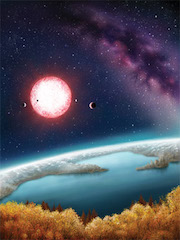18th April, 2014
Astronomers said they have found an Earth-sized planet, outside our own solar system, orbiting a star at a distance suitable to allow liquid water on the planet’s surface. But do not dream yet of living in the planet designated as Kepler-186F: Kepler-186f is measured to be so far away from us that even moving at light speed, it would take almost an estimated five centuries to get there. Any radio or light signals reaching us from the planet would be that old also.
Still, “this is the first definitive Earth-sized planet found in the ‘habitable zone’ around another star,” said Elisa Quintana of the SETI Institute at NASA Ames Research Center in Mountain View, Calif. She is the lead author of a report on the findings published in the research journal Science.
“Finding such planets is a primary goal of the Kepler space telescope,” she added. “The star is a main-sequence M-dwarf, a very common type. More than 70 percent of the hundreds of billions of stars in our galaxy are M-dwarfs.”
The finding will surely shape future investigations of exoplanets, or planets outside our own solar system, with possible Earth-like surfaces, scientists said. The body is the fifth and outermost world to be detected in the planetary system of a red dwarf star known as Kepler-186. The star lies approximately in the direction of the constellation Cygnus, the Swan, in the northern sky on the plane of the Milky Way.
Of the nearly 1,800 confirmed exoplanets found in the past two decades, about 20 are thought to orbit their host star in the habitable zone—a range of orbital distances at which surface water on a planet with an atmosphere would neither freeze nor boil. But all of these are larger than Earth, so they might be gaseous planets, like the larger planets of our own solar system. The authors estimate the newfound planet is less then 10 percent wider than Earth, based on a measured dimming of starlight from Kepler-186 as the planet passes in front of it.
Theoretical models suggest that planets up to about 1.5 times as wide as Earth “are unlikely to be swathed in atmospheres of hydrogen and helium, the fate that’s befallen the gas giants of our own solar system,” explained Thomas Barclay, a staff scientist for the Kepler mission affiliated with both NASA and the Bay Area Environmental Research Institute.
So “Kepler-186f is likely a rocky world, and in that sense similar to Venus, Earth and Mars.”
.Written by SETI Institute and World Science Staff



